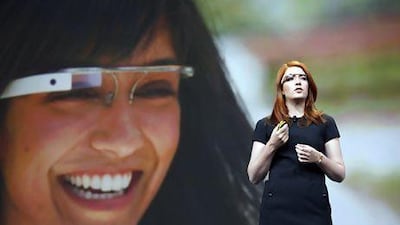Several years ago, when Chris Cox was running his own manufacturing business in Asia, a client asked him to mount a video camera on a rifle.
"It seemed like an awful idea for numerous reasons," recalls Mr Cox.
"Then we said, 'Wait a minute, why would you want this? It's because you want your true point of view while using the rifle.'"
That desire to capture a first-person perspective eventually led Mr Cox to create a line of sunglasses, known as Pivothead.
Each pair includes a camera embedded inside the bridge and a switch on the arm to activate recording in high-definition video.
More than a dozen models were released last year, at a cost of US$299 (Dh1,098) per pair, for all sorts of customers: sports buffs; outdoor enthusiasts such as mountain climbers; musicians for when they play live; and even chefs with an appetite for capturing their culinary creations on film, so to speak.
"That's what our camera is really for," says Mr Cox. "It's for life."
So-called smart glasses are poised to grab a growing slice of the digital camera and video recording market, analysts say. Revenues generated by these high-tech shades are forecasted to grow to nearly $12 billion by 2015, according to ABI Research.
But will these lenses be transformative the way smartphones have been for taking snaps or capturing live footage?
One of the biggest potential players in this market, Google, is still teasing observers with its wares.
Known as Google Glass, its device includes a video camera and technology that allows someone wearing it to make all kinds of voice commands - similar to how software called Siri lets people ask for directions or the temperature on certain Apple devices.
According to footage and information shared by Google on its site, people can say a simple statement such as, "'OK, Glass, record video," and it does. It also seems designed to follow voice commands and snap photos on demand or pull up pictures and navigational directions on an interior lens. Content may also be shared with loved ones and friends, presumably through sister sites such as Google+ or YouTube.
Applications for being one of the first people to get hold of the device are now closed, Google says, although the company notes "there will be more chances to get Glass at a later date".
Josh Flood, a senior analyst with ABI Research, says Google is selling each set of glasses at $1,500 to developers, who are working confidentially on software programmes for the devices. "They'll probably set the release of this in the beginning of 2014," says Mr Flood.
Google declines to comment.
A number of other companies are working on similar gadgets within this space. Vuzix has modelled its forthcoming Smart Glasses M100 on an ear-mounted Bluetooth set that works with a smartphone.
In this case, the Vuzix device includes a small display in front of the eye that shows information accessed from a mobile phone or basic data from the Web. It also records high-definition video or still images through a camera.
This month, Vuzix announced it had started shipping its M100 glasses to certain developers who could create and test apps on actual hardware.
"This new category of device is going to revolutionise many markets by injecting cloud-connected, hands-free and geospatially accurate information to applications that desperately need it," says Pete Wassell, the president of Augmate, one of Vuzix's partner developers.
Vuzix notes on its site that the M100 glasses are "coming soon".
Another one of its glasses, the Wrap 1200 video eyewear, is already available to the public and is selling for $500. This model looks like a more traditional pair of sunglasses but plays movies - including those made in 3D - on the interior lenses by creating a virtual 190cm display.
"There is definitely foreseeable value for the augmented reality technology as a whole," says Tim Tang, an analyst with IDC, a market research firm.
"The idea of labelling objects with more information in real time is very useful," he adds. "For instance, a reference to parts under a [car bonnet] when you are troubleshooting."
Another technology company, Kopin, is pitching what is known as the Golden-i. This wearable headset is a clunky addition within this sector, designed for use by emergency medical staff or industrial workers.
Announced earlier this year at the International Consumer Electronics Show, it wraps around the head and includes a small display, plus a camera, GPS and Bluetooth technology, as well as gesture control, speech recognition and noise cancellation features.
It is meant to be handy for difficult environments where pulling out a laptop is simply not feasible. However, Mr Flood notes, "They brought the product to market in a short time and will probably have to tweak a few things."
Kopin did not respond to requests for comment.
Mr Cox had plenty of tweaking to do before he launched his Pivothead glasses, which are now selling in 50 countries and through retailers such as Sports Authority and Sunglass Hut.
Two years ago, the device was displayed at an exhibition where it won an industry award but was not publicly released. "There were too many issues with it," says Mr Cox. "It was just not ready."
There were some bugs in the electronics, which kept freezing and Mr Cox did not believe the quality of the camera was strong enough. He kept tinkering with prototypes until he felt he got it right.
Overall, the project's cost ran well over its initial budget, totalling about $2 million, and took more than two and a half years to complete.
Yet sales have been growing of late, says Mr Cox, who will not disclose exact figures.
Both military organisations and law enforcement agencies in different parts of the world have started ordering pairs for their officers, while doctors, dentists and journalists have also shown interest.
"Now, in hindsight, I'm glad we did it," says Mr Cox.

